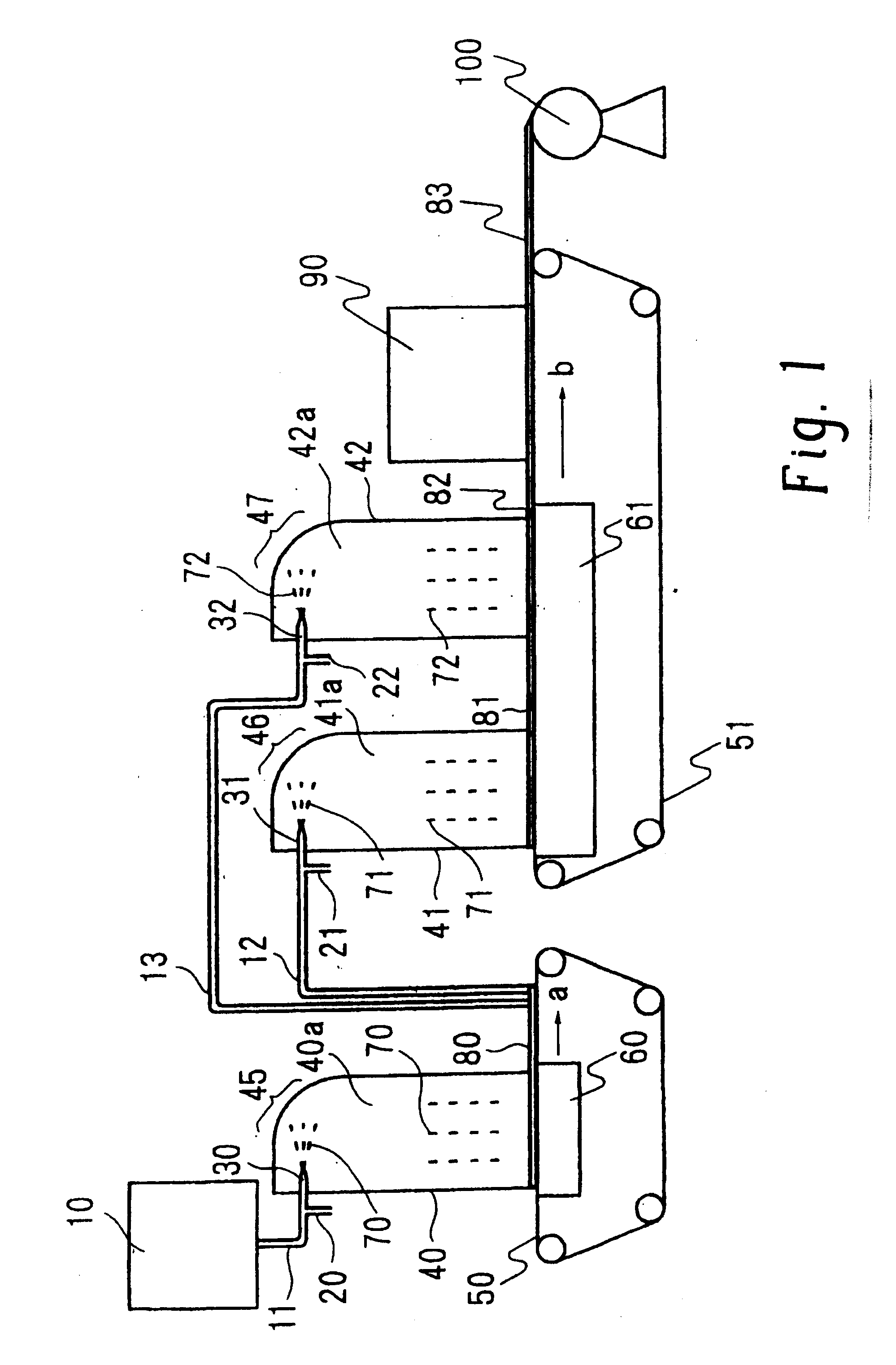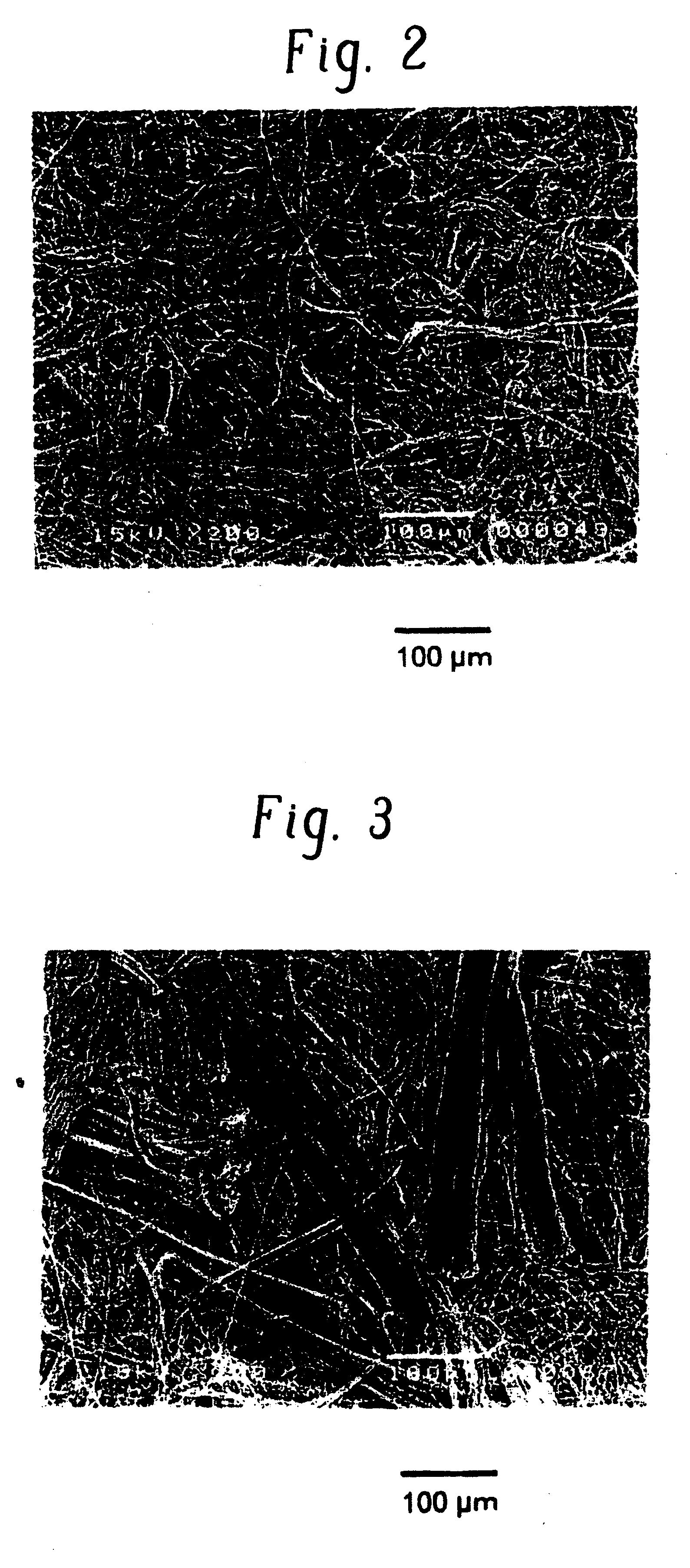Fine-fibers-dispersed nonwoven fabric, process and apparatus for manufacturing same, and sheet material containing same
a technology of fine fibers and nonwoven fabrics, applied in the direction of weaving, raw material division, manufacturing tools, etc., can solve the problems of high pressure loss, insufficient filtering characteristics or pliability, etc., and achieve excellent properties, small pressure loss of the fine fibers-dispersed nonwoven fabric layer, the effect of small pressure loss
- Summary
- Abstract
- Description
- Claims
- Application Information
AI Technical Summary
Benefits of technology
Problems solved by technology
Method used
Image
Examples
example 1
[0088] Islands-in-sea type fibers (fineness=1.7 dtex) having 25 island components of high-density polyethylene and polypropylene in a sea component of polylactic acid were prepared by a composite spinning method, and cut to a fiber length of 1 mm. The resulting islands-in-sea type fibers were dipped in a 10 mass % aqueous solution of sodium hydroxide, and the sea component of polylactic acid was extracted and removed by hydrolysis. Then, the product was air-dried to obtain bundled aggregates of the fine fibers A (a fiber diameter=2 μm; a fiber length=1 mm; adhesion rate of adhered substances=less than 0.02 mass %; sectional shape=circle, and islands-in-sea type) wherein high-density polyethylene and polypropylene were coexistent in each of the fine fibers. The resulting fine fibers A were drawn but not fibrillated. Each of fine fibers had substantially the same diameter in an axial direction thereof.
[0089] On the other hand, islands-in-sea type fibers (fineness=2 dtex) having 61 is...
example 2
[0098] The bundled aggregates of the fine fibers A prepared as in Example 1 and aggregates of polyester fine fibers (Teijin Ltd.; fineness=0.11 dtex; fiber diameter=3.2 μm; a fiber length=3 mm; adhesion rate of adhered substances=less than 0.02 mass %) which was washed with acetone to remove adhered substances (mainly a fiber auxiliary) were charged into the mixer at a mass ratio of 60:40, and loosened and mixed. The polyester fine fibers were drawn and not fibrillated. Each of polyester fine fibers had substantially same diameter in an axial direction thereof.
[0099] The mixture of the aggregates of the fine fibers was supplied to a cylindrical ejector having a cross-sectional circular shape at an ejecting opening (diameter=7 mm), and at the same time, a compressed air (pressure 6 kg / cm2) was introduced from the compressed-gas inlet at an inside position near to the cylindrical ejector. The mixture of the aggregates of the fine fibers was ejected from the cylindrical ejector (where...
example 3
[0103] Islands-in-sea type fibers (fineness=8.8 dtex) having about 3900 island components of poly-4-methylpentene in a sea component of polyester copolymer were prepared by a melt blend spinning method, and cut to a fiber length of 0.5 mm. The resulting islands-in-sea type fibers were dipped in a 10 mass % aqueous solution of sodium hydroxide, and the sea component of polyester copolymer was extracted and removed by hydrolysis. Then, the product was air-dried to obtain bundled aggregates of the fine fibers C (a fiber diameter=0.4 μm; a fiber length=0.5 mm; adhesion rate of adhered substances=less than 0.02 mass %) of poly-4-methylpentene. The resulting fine fibers C were drawn but not fibrillated.
[0104] Further, the bundled aggregates of the fine fibers A were prepared as in Example 1.
[0105] Thereafter, the bundled aggregates of the fine fibers A and the bundled aggregates of the fine fibers C were charged into the mixer at a mass ratio of 50:50, and loosened and mixed. The mixtur...
PUM
| Property | Measurement | Unit |
|---|---|---|
| length | aaaaa | aaaaa |
| diameter | aaaaa | aaaaa |
| diameter | aaaaa | aaaaa |
Abstract
Description
Claims
Application Information
 Login to View More
Login to View More - R&D
- Intellectual Property
- Life Sciences
- Materials
- Tech Scout
- Unparalleled Data Quality
- Higher Quality Content
- 60% Fewer Hallucinations
Browse by: Latest US Patents, China's latest patents, Technical Efficacy Thesaurus, Application Domain, Technology Topic, Popular Technical Reports.
© 2025 PatSnap. All rights reserved.Legal|Privacy policy|Modern Slavery Act Transparency Statement|Sitemap|About US| Contact US: help@patsnap.com



